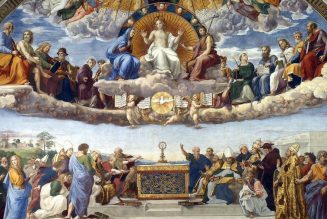The architecture of the church—the spire, the stained-glass windows, the cold, the acoustics, the hardness of pews—fills us with a sense of the sublime. Its greatness creates in us a feeling not of inferiority but of human scale, a scale that must be remembered in the face of God.
 For those of us of faith, 2020 was a strange year indeed. The weekly routine of churchgoing was disrupted just as much as any other, and though many attempts to compensate for the “new normal” were made—such as online sermons and Mass—for a great many of us, the worship cannot be so neatly distinguished from the setting.
For those of us of faith, 2020 was a strange year indeed. The weekly routine of churchgoing was disrupted just as much as any other, and though many attempts to compensate for the “new normal” were made—such as online sermons and Mass—for a great many of us, the worship cannot be so neatly distinguished from the setting.
Those that receive communion, for instance, lost a significant part of their practice, and not celebrating the Eucharist is spiritually painful. At the end of 2020 came the recognition of the necessity of keeping churches and other spiritual sites of worship open, and it allowed for the resumption of such an essential part of worship. The debate that crept out before such recognition, however, was over the actual physicality of worship: Do we, as Christians, need to worship in a particular place? After all, there is a reason why we refer to the collective body of Christians as the Church, despite us being so dispersed; it is because a community does not need to affix itself to a particular locality to truly be.
The question, naturally, turns to the actual space of churches, as the very buildings in which we congregate to pray. Of course, Christians do not reserve our Christianity for Sunday inside the walls of the Church; we practice the Word in our daily lives, and spread the Gospel wherever we go. But there is often an understated part of this discussion, and that is of the architectural significance of churches themselves. It is the purpose of this article, therefore, both to make the argument that churches ought to be built in a specific way, and to vindicate the austere setting we associate with churches in England.
It is worth pointing out at the outset that religious architecture in the Christian tradition is intentionally overawing. The church I attend in Edgbaston—St. Augustine’s of Hippo—is located at the centre of a roundabout-style circle of grass around which a number of residential buildings congregate. In times past, the spire of the church would have been the most visible construct for miles, but modern dwellings have taken a decidedly less supplicatory turn, and now flats stand either as tall as, or just a little shorter than, the spire.
What is noticeable, however, is the difference between those residential buildings and the spire in the reaction they produce in the observer. When you round the corner to approach to church, you are confronted with the faceless and lattice-like flats that replicate the same monotonous floors. You see this once, and you have seen it all; especially in modern blocks of flats, there are no gildings or stonework that arrest your attention for anything longer than a moment.
Contrast this, for instance, to the church itself. When you see it, your eyes are instantly drawn up. The spire, so consciously pointing to Heaven, is decorated with accoutrements, both humble and bold, which entertain the eye, tease the aesthetic gaze ever upwards, and remind you, almost unconsciously and immediately, of the focus of this place. It is not this world, but the world beyond, the place where God dwells, behind the physical façade of the real, and in the transcendental space of Eternity.
Just as you marvel at the spire, so too do you notice the humility of the external building itself. With the neatly-sloped roofs and crisscrossing brickwork, the eye is drawn to the only ostentatious parts of the church: the stained-glass windows. Even these, however, are humbly hidden and can only truly be appreciated from inside. Thus, you are drawn into the building itself almost relentlessly.
It is when we enter the church, however, that we truly feel that sense of awe at its zenith. Whenever I walk into a church or cathedral built in the classical or vernacular styles, I always notice how cold it is. My breath coalesces in the air before me, and the faint breeze that comes from somewhere tickles the back of my neck. I find myself wrapping my coat tighter and burying my hands in my pockets. At the same time, the hollow falls of my footsteps reverberate into the chill air around me, and even the slightest noise is carried away across the pews, in such a way that I find myself whispering to the churchwarden as I take the pew sheet. I strain to see the pew sheet in the close darkness as I sit on the hard wooden seats, and compare it to the dusty prayer and hymn books to find that week’s verses.
Some might think this description a negative one—indeed, it does not sound comfortable—but this is not the point. When entering the church, we are overawed by the surroundings, all of which work together to create a sense of smallness in us, a feeling not of inferiority but of human scale. A scale that must be remembered in the face of God. Some commentators have gone so far as to say that this discomfort is the point; Roger Scruton said much the same in England, An Elegy, when he wrote of the hard wooden pews as an incentive to good posture and even as compulsion for us to prefer kneeling. Peter Hitchens, too, noted that the oft-derided language of the King James Bible was intentionally difficult to read because it forces us to pay attention to what we are saying and so to recognise the weight of those words.
All of this, however, does something more for the Christian soul; it fills one with a sense of the sublime. This concept, the “sublime,” is uniquely misunderstood in the philosophy of aesthetics, but it is the most accurate description of the feeling I have at the threshold of a church. In the mid-eighteenth-century work, entitled A Philosophical Enquiry into the Origins of our Ideas of the Sublime and the Beautiful, Edmund Burke wrote that we could understand the sublime as something akin to “pleasurable terror.” What this seemingly paradoxical term actually means, is that terror is “the strongest emotion which the mind is capable of feeling.” It paralyses us when we experience it in its purest form: “the mind is so entirely filled with its object, that it cannot entertain another.”
Although terror is often understood as a painful experience, Burke tells us, it can be pleasurable when associated with the right thought: “The passion caused by the great and the sublime in nature, when those causes operate most powerfully, is Astonishment; and astonishment is that state of the soul, in which all its motions are suspended, with some degree of horror.” Simon Court, in an excellent essay, observed that “another source of the sublime is what Burke calls infinity, where the eye is not able to ‘perceive the bounds’ of something, or ‘see an object distinctly’, and this gives rise to a ‘terrible uncertainty of the thing’ perceived.” “Infinity has a tendency to fill the mind with that sort of delightful horror, which is the most genuine effect, and truest test of the sublime.” Imagine, for instance, standing at the precipice of a cliff-face: It is there that we experience a true moment of the sublime in nature.
What concerns me more, however, is what the sublime shows us regarding our faculty for reason. As Burke says of reason and terror, the sublime emerges in that most paralysing moment when our reasonable mind is incapable of contemplating anything but the object it beholds. It reveals to us, in other words, the very edge of our capacity for knowledge. This is not the same as the edge of our knowledge, which one can, by learning, expand further. The point here is specifically that the sublime reveals the edge of our capacity for knowledge and gestures towards the most incomprehensible of things: the transcendental, of which we can only find mere expressions in the world.
The sublime, in other words, reveals to us through the pure moment of astonishment the limits of our capacity for rational thought and understanding.
I find much the same when I walk into a church. I am not there for pleasure; I am there to behold the Word of God, and the sublime setting of the church enhances that feeling. So how can the sublime be rendered in brick and mortar? Simply through those elements of the church I have enumerated above: the cold, the acoustics, the darkness, the hardness, the age. All of these work together to create a sublime setting.
But what, it must be asked, does this have to do with God? As Burke reminds us, the sublime is pleasurable terror, the feeling that, through revealing the limits of our rational mind, returns us to the ground on which we stand and the world in which we live, provided that terror is associated with a good thought—and what thought could be more full of goodness than God? God, however, exists in the transcendental realm; He is immaterial and beyond natural limits, and so beyond our natural comprehension. Hence, thoughts of Him must be summoned into our unconscious mind through the Word and through the places in which we worship him. It is there in that cold, dark, uncomfortable hall that we find God.
The Imaginative Conservative applies the principle of appreciation to the discussion of culture and politics—we approach dialogue with magnanimity rather than with mere civility. Will you help us remain a refreshing oasis in the increasingly contentious arena of modern discourse? Please consider donating now.
The featured image is courtesy of Pixabay.
.pf-button.pf-button-excerpt { display: none; }
Join Our Telegram Group : Salvation & Prosperity










